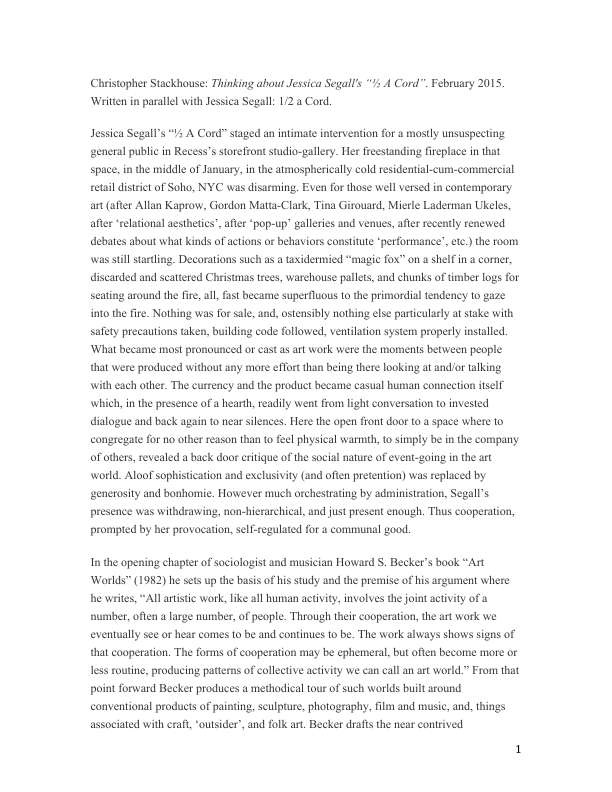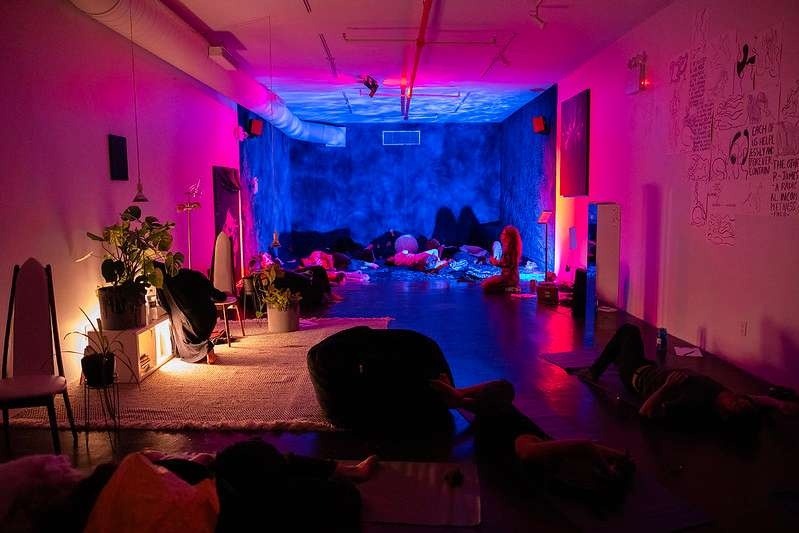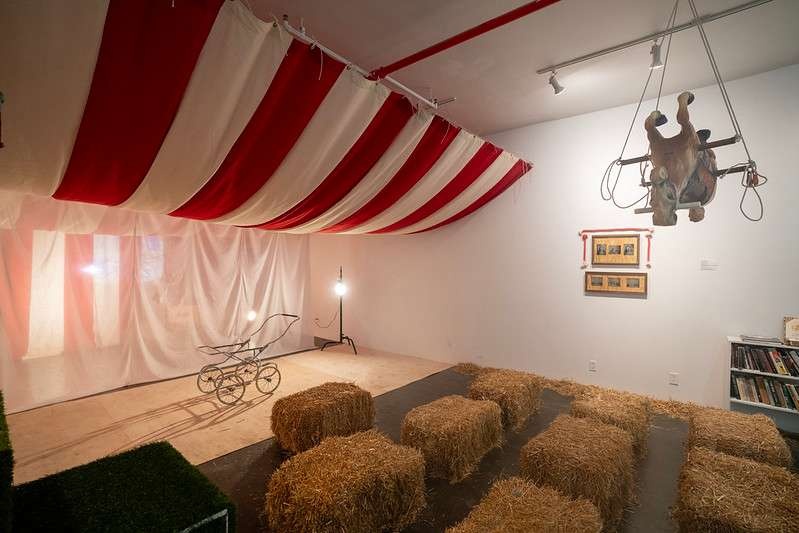Jessica Segall’s “½ A Cord” staged an intimate intervention for a mostly unsuspecting general public in Recess’s storefront studio-gallery. Her freestanding fireplace in that space, in the middle of January, in the atmospherically cold residential-cum-commercial retail district of Soho, NYC was disarming. Even for those well versed in contemporary art (after Allan Kaprow, Gordon Matta-Clark, Tina Girouard, Mierle Laderman Ukeles, after ‘relational aesthetics’, after ‘pop-up’ galleries and venues, after recently renewed debates about what kinds of actions or behaviors constitute ‘performance’, etc.) the room was still startling. Decorations such as a taxidermied “magic fox” on a shelf in a corner, discarded and scattered Christmas trees, warehouse pallets, and chunks of timber logs for seating around the fire, all, fast became superfluous to the primordial tendency to gaze into the fire. Nothing was for sale, and, ostensibly nothing else particularly at stake with safety precautions taken, building code followed, ventilation system properly installed. What became most pronounced or cast as art work were the moments between people that were produced without any more effort than being there looking at and/or talking with each other. The currency and the product became casual human connection itself which, in the presence of a hearth, readily went from light conversation to invested dialogue and back again to near silences. Here the open front door to a space where to congregate for no other reason than to feel physical warmth, to simply be in the company of others, revealed a back door critique of the social nature of event-going in the art world. Aloof sophistication and exclusivity (and often pretention) was replaced by generosity and bonhomie. However much orchestrating by administration, Segall’s presence was withdrawing, non-hierarchical, and just present enough. Thus cooperation, prompted by her provocation, self-regulated for a communal good.
In the opening chapter of sociologist and musician Howard S. Becker’s book “Art Worlds” (1982) he sets up the basis of his study and the premise of his argument where he writes, “All artistic work, like all human activity, involves the joint activity of a number, often a large number, of people. Through their cooperation, the art work we eventually see or hear comes to be and continues to be. The work always shows signs of that cooperation. The forms of cooperation may be ephemeral, but often become more or less routine, producing patterns of collective activity we can call an art world.” From that point forward Becker produces a methodical tour of such worlds built around conventional products of painting, sculpture, photography, film and music, and, things associated with craft, ‘outsider’, and folk art. Becker drafts the near contrived interconnectedness of parts and people that create conditions of production and distribution of art as an elastic industry of goods and services. A glance at a few chapter titles in the table of contents- “Mobilizing Resources”, “Distributing Works of Art” (which has an accessible description of the power and function of patronage), “Aesthetics, Aestheticians, and Critics”, or “Art and the State” – make clear in brief his assessment that extensive calculation goes into convincing us what is and what is not art at any given moment in history or in our own time.
Becker is being purely scientific (not simply cynical) when he concludes in “Reputations”, the final chapter of the book, “[in] this way, we might say (with more warrant than it is usually said) that the world of art mirrors society at large.” There are, in both (art/life), the binaries of the powerful and the powerless, and the varied negotiations of the middle. New York City in 2015 presents an unnerving miniature example of the incentives, achievements, deficiencies, and changeability shared between an art world and the social order contained by the city’s greater inhabitants and transients. Artists, in a very deep sense, no matter where they stand socio-politically (and no matter what they tend to say under whatever circumstance they find themselves), are attuned to nuanced and brutal realities of trying to operate in a city where there is an extreme disparity of wealth and privilege on display, and where the only real constant are extreme expressions of public and private discourses on socio-economic power. Artists in particular have responded to such an environment, be it in a city-state, state, or nation in myriad ways for centuries. The most recent highly visible mobilization of creative people coming together to revolt or describe such revolting economic conditions in the United States happened during the OWS movement, where “collective activity” and “cooperation” did not seek to serve capitalist production. Those actions sought the explicit opposite.
Attempts at open-ended engagement of this sort do not happen without predicament. Cost is a fact of life that most have become accustomed to exploiting for profit however large or small. This is a symptom of the capitalist system in which we are caught. An art practice that insists on envisioning aesthetics of generosity is bound to generate skepticism in light of financial realities and the dominant economic models that facilitate art making. Under the current circumstances artists, like everyone else, have to make a living, and so follows the logic that everything an artist produces under that nomenclature must be toward that incentive. This logic could extend to the idea that artists pursue various kinds of ‘living’ that circumvent the pecuniary controls that define power relations between people, by defining or at least articulating variations of social and cultural capital (Bourdieu) as essential to an evolution beyond the oppressive capitalist paradigm and its strictures. Most importantly, we can bring to the fore the human value of creating and maintaining free spaces for public gathering to neighbor members of varying populations for the purpose of familiarity and idea exchange. The hope is that project’s like Segall’s here can suggest that an inclusive egalitarian venue is or can be an interactive art work. Perhaps one where success can actually be measured by the conversations generated, and how ideas and knowledge between people are shared by virtue of it. This would be especially true if alternative public education organizations and facilities were initiated according to the community’s interest.
Such efforts can bring nuanced attention to the effects that practices like land banking and real estate property speculation have on inflating rents, and producing artificial shortages of affordable residential and commercial spaces, and fewer recreational parks (or perhaps just truly public spaces).These unchecked socioeconomic hierarchical organizations of space have a direct impact on artists, and stifles the centralization of arts communities out of which important social activities that bond artists and communities can emerge. Even the most casual conversation if persistently pursued can be revelatory. Urban gentrification is typically led by artists. Artists move into an area where either no one wants to live, work or play, or where for one reason, or another, a municipality has abandoned it. Artists bring the spirit of experimentation, curiosity, and willingness to take risks in order find or create economic conditions and foster environments that are conducive to the survival of their practices. Turning that effort toward seizing interior, exterior, private and public space as means of interceding on behalf of the greater disenfranchised population rather than displacing or further marginalizing financially disempowered groups (which eventually artists themselves become after being harbingers of “development”, “urban renewal”, etc) is an underappreciated art form. Instead of contributing to the physical displacement of communities, perhaps presented in light of what once naturally occurred that now has become capitalist calculation, artists can reconsider their role in gentrification more specifically, actively, invested in artistic, conceptual terms.
Segall’s event producing installation fits well, for instance, into Joseph Beuys’s theory of Social Sculpture. Beuys’s conception of society as a potentially ever-expanding artwork, rhymes with Howard Becker’s precise and extensive diagram of art and society. Beuys takes Becker’s work to a logical next step (or through a series of next steps) saying that collaboration and cooperation among individuals, that all human activity in such a paradigm, is art work, and, contribution to an even greater artwork envisioning transformation of society. Where Becker presents political information in an apolitical tone, Beuys, passionately and relentlessly politicizes the very idea of artistic production. Segall also managed to avoid providing or becoming entertainment, which is the performative default in a situation like this that insists on the engaging presence of the artist. Performativity exists in static, object-material art as well, because it is a byproduct of what is required to maintain an art world; that is to say people enact designated roles of ‘artist’, ‘audience’, ‘dealer’, ‘collector’, etc, by reflex on cue, without challenge to what that role may actually mean to personhood beyond learned and encouraged perfunctory behavior. Derailing the passivity required by consumerism (hyper-consumerism or the ethos of American consumerism) happens when the mode of exchange that supports that habit is subverted. In the case of “½ A Cord” Segall’s abstention encouraged participation rather than produced an audience. However still, her intentions revealed themselves complicated with her stylistic response to the conceptual naming of the work an “urban campsite.” For instance, the contents of the space (e.g., conifer trees) steered perception toward the bucolic as opposed to metropolitan post-industrial, and, toward the feel of the cottage as opposed to the downtown loft. These contradictions, these opposites, could have been a discursive element integral to the piece but were not. Even the distribution of “campsite rules” which prohibited fire arms, fire works, indecent exposure, and littering were listed among items included for poetic style and charm – “Do not disturb the magic fox” or “Feel free to feed the crickets.” Healthily so, Segall’s endeavor remained unstable if not completely agile, providing few if any windows for interpretation.
Art certainly need not be consciously politicized by artists. Whether artists like it or not, art is ultimately being instrumentalized for political ends, to preeminently serve an oligarchy, especially in the global network of which New York’s art world is intrinsically part. What makes artists look foolish is pretending that this is not the case because it is inconvenient to whatever it is whichever artist is trying to achieve. It is much easier to strategically pretend to be naïve. Yet, the challenge of deciding what to do with given circumstances is a hard one – up to a point. At what juncture does an artist evaluate the incentives to make art? Though not prescriptive, perhaps even a bit too neutral when not ambivalent, art critic/philosopher Boris Groys’ essay “Becoming Revolutionary: On Kazimir Malevich” provides an assessment of Russian avant-garde art before/during/after the revolution that took place in that country in 1917, focusing on Malevich as the artist “most [radically] representative” of that time period. Russian history is married to the general study of European art history as a way of framing a conversation about politics, social change, phenomenological aspects of art, belief systems, and the rationality and irrationality of faith, and so, in all manners. Throughout the piece “change” is equated with “destruction.” Groys anecdotally (and ominously) adds, “change is our status quo.” Groys begins from there via Malevich to abstract art from material object association to determine the “indestructible character of art.” The physical objects produced as such are marginal to the essence of art. As speculative as any philosophical/critical essay about the nature of art tends to be, compressing the rich thoughts, diplomatic agendum, and far flung interests of the writer is not doable, nor fair if it was; but there is important anchoring language to excerpt from it, in thinking about Segall’s “½ A Cord” –
Today, the political role of art is mostly seen
as being twofold: (1) critique of the dominant
political, economic, and art system, and (2)
mobilization of the audience toward changing
this system through a Utopian promise.
And this –
After all, what is revolution? It is
not the process of building a new society this is
the goal of the post-revolutionary period. Rather,
revolution is the radical destruction of the
existing society. However, to accept this
revolutionary destruction is not an easy
psychological operation. We tend to resist the
radical forces of destruction, we tend to be
compassionate and nostalgic toward our past
and maybe even more so toward our endangered
present.
About the artist
Christopher Stackhouse
Christopher Stackhouse is a writer, artist, curator and critic. His books include image/text collaboration, Seismosis (1913 press), which features his drawings in dialogue with text by writer/translator/artist John Keene; and a volume of poems, Plural (Counterpath press.) With artists Jared Friedman and Jomar Statkun, Stackhouse is a founding member of the roving artists in residence project This Red Door. He teaches at the Maryland Institute College of Art.
Explore/Archive
See allDecember 2025
The INSTITUTE FOR TRANSHUMANIST CEPHALOPOD EVOLUTION and Learning from Octopuses
Barbara London
Barbara London reflect's of Miriam SImun's INSTITUTE FOR TRANSHUMANIST CEPHALOPOD EVOLUTION
October 2025
streamlined reflections, courtesy of noise canceling headphones
Gabrielle Rucker
Gabrielle Rucker reflects on the radical intimacy and auditory life at the heart of Deli Radio
July 2025
Tell My Jockey: CUNTRY’s Discourse From the Horse’s Mouth
Ericka Pérez
Assembly fellow Ericka Pérez reflects on clowning, resistance, and CUNTRY’s radical refusal to perform.







